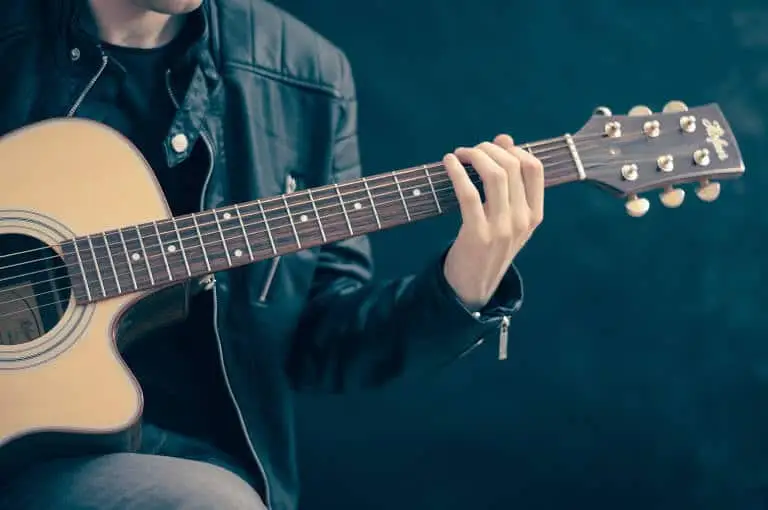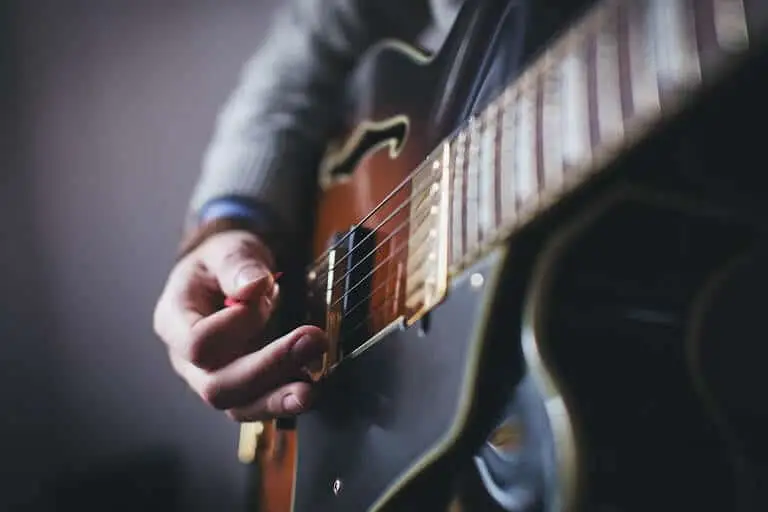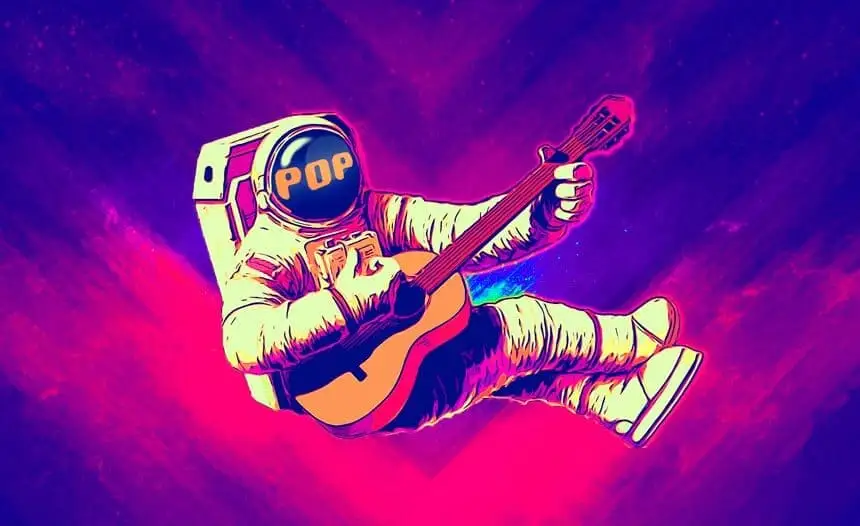Catchy hooks, moving lyrics, and melodies that get stuck in your head – a good pop song can undeniably reel you in from start to finish. It may seem impossible to write that one-of-a-kind pop song that people want to play on repeat – but by learning a few pop pointers and structure guidelines, you'll be able to write ear worms in no time at all.
With this pop song writing guide, you can gather all the knowledge you need to learn how to write a pop song from start-to-finish.
Writing A Great Pop Song in 8 Steps
Without further ado, here is the step-by-step process for writing a pop song. Using this formula, you'll be able to write radio-ready tunes from the comfort of your home.
1. Let Your Ideas Flow And Press Record
This may sound silly, but it’s often an easily forgotten step in the songwriting process – before you do ANYTHING, pull out your phone (or use your DAW of choice ) and start recording your songwriting session.
Don’t wait to record when your song is “perfect.” Even if you think you’re not coming up with anything exciting, you’ll regret it when you suddenly can’t remember that golden nugget of songwriting that you just came up with but forgot to record. You may have to sift through a 20-minute voice memo later to find that great idea, but it will be worth it!
Learning how to write a pop song isn't always a linear process, so you need to be willing to let yourself sit and experiment with ideas that may not be fully fleshed out yet. Like any skill, pop songwriting is most difficult when you haven't turned it into a habit. Once you get used to writing a pop song, the process will undoubtedly get easier, you just need the courage to get started.
Even some of the most successful and famous songwriters in the music industry still record ideas on voice memos and let themselves experiment with seemingly nonsensical ideas. As a bonus track on her ‘1989’ album, Taylor Swift released a voice memo from the early songwriting stages of her hit, ‘Blank Space,’ where you can hear her playing the song on acoustic guitar with unfinished lyrics, as songwriters/producers Max Martin and Shellback shout out production ideas.
“We like to run a recording on our phones of everything we’re doing when we’re putting a song together just in case one of us blurts out a cool melody and we forget about it…we wanna go back and replay the tape so we can remind ourselves of exactly what we were saying.”
– Taylor Swift (From ‘Blank Space Voice Memo’ on ‘1989’)
If you ask ten great songwriters how they start writing a song , each one of them will probably give you a different answer. Some start with melodies, some start with lyrics , some start with chords, some start with a track – it’s different every time. You can gather inspiration from anywhere and everywhere if you put enough time into it. One great example is from Sia on how she gathered inspiration for her hit song "Chandelier":
“I’ll choose lyrical content from a list of concepts I have in my phone, and whenever I think of one, I write it down. I usually choose a word, one solid concept. So say I’m looking around and I see a chandelier, I think ‘oh, how can I use that?’ … There’s a lot of strategy that goes into it.”
– Sia Furler
There is no one way to write a song – that may seem intimidating, but it’s really the beauty of songwriting. Pop songs tend to have similar elements, though occasionally great songs break the rules. There’s no wrong way to start a song as long as it inspires you. Whether it’s a melodic hook you have in your head or a cool chord progression on your guitar , your inspiration is what will set your song on the right path.
That being said, there are some common features of pop music that may be helpful to incorporate into your songwriting process. Pop songs prioritize great storytelling that connects with the listener, catchy repetition, and an effortless melody that's bound to get stuck in your head.
2. Understand Pop Music's Key Elements
Once you've gotten in a good headspace to start writing the next radio hit, it's a good idea to make sure you understand the magic of pop music. There isn't one formula that will work every time, but there are some key elements that will help you craft a worthwhile pop tune that's more likely to stick with listeners. Each songwriter might have his own set of "golden rules", but here are a few that come up fairly often:

- Keep things short and sweet. Part of the magic of pop music is that they're irresistibly addicting. The short, snappy, and memorable nature of the art form leaves listeners wanting more and hovering over the "repeat" button. Therefore, try to keep your tune under 3 minutes if possible.
- Find a melody or chorus that sticks. Catchy pop songs are all centered around an unforgettable chorus or melody that gets stuck in your head. You should spend most of your time fine-tuning these elements for the best results. When it comes to writing pop songs, thoughtful repetition is your best friend.
- Make it relatable. "Pop" is short for popular for good reasons. If you want your music to connect with the masses, you'll need to produce a tune that connects with a large mass of listeners in an authentic way. Most pop songs center around around a relatable topic that draws from a listener's experience like love and heartbreak or following your dreams.
- Study your favorite pop songs. One of the best ways to truly understand the structure of popular songs is by actively listening to some of your favorites. Put on some of your favorite songs and listen in to see how the singer moves effortlessly from the verse, pre chorus, to the hook and back again. Pay special attention to a hit song if the melody lines won't seem to leave your head. You can also ask other songwriters how they write pop songs to gain insight on their process. You'll find that every artist has their own nuanced process, which can give you the freedom to try out different creation styles while pursuing what works for you.
3. Build Upon Your Inspiration
Don’t be discouraged if you can’t come up with a perfect verse or chorus right away. You can start building your song with just chords, or just melodies without lyrics, or even lyrics without melodies. Here are some ways to build on your inspiration and start constructing your song:
Loop a chord progression

There are plenty of apps you can download like Loop ON and Jam Looper to easily record and loop ideas. If you have a chord progression that inspires you , record it and loop it, and sing or play whatever ideas come to you (remember to have a voice memo recording going)! Maybe you’ll come up with a cool melody, or maybe while you’re solo-ing on your guitar you’ll come up with the perfect instrumental hook!
If starting with chord progressions isn't your style, don't fret. A good pop song can begin with just a melodic or strong lyrical idea, even without a backing track. With that in mind, if you do have access to a backing track or can play different chords on a guitar, having these as a reference throughout the writing process can be immensely helpful.
Sing with “mush mouth.”
If you have some great melodic inspiration but can’t come up with lyrics, try building on your melodies without lyrics! As you’re creating new melodies, sing them with “mush mouth” (basically nonsense syllables and words) to construct your rhythms and hooks without having to come up with all the lyrics at once.
Sometimes keywords will jump out at you and help you figure out what the lyrics will be, and listening back to the syllables you sing will help you figure out which words will fit in with your melodies! When it comes time to start writing lyrics , you'll already have the melodies for the track in mind so it'll be easier to put two and two together.
Make a bubble map with lyric ideas.
Although this method may seem like a throwback to elementary school days, it can actually be a helpful tool for building on a concept or lyrical idea. Let’s say you’re inspired by the concept of unrequited love. Put that in the center of your map and start jotting down words or ideas that relate to that concept, like “hurting,” “keeping feelings secret,” “bittersweet,” etc.
They might not be complete lyrics, but they can help you flesh out your concept and give you key words that you can use to convey the emotion of the song. Once you have the song written, go back and cut out or adjust lyrics that don't quite fit within the melodic song structure.
4. Add Song Structure and Form
Once you have fleshed out your inspiration, concepts, and melodic and lyrical ideas, it’s time to start adding some structure. There are many different song forms and structures to work with in pop songwriting – you can challenge yourself to write to a specific form, or see what form naturally fits your songs.
In order to understand pop song structure, it can be helpful to assign certain sections to letter values. For instance, in the structures discussed below, we refer to an "A", "B", and "C" section referring to separate parts of the song that have their own distinct melody.
Having these values can be helpful since pop songs are known for utilizing repetition: Instead of saying the verse comes first, then the chorus comes, and finally the verse returns, we can say that the pattern is A-B-A with A equating to the repeated verse section and B acting as the chorus.
With that in mind, here are some examples of three common pop song structures that you can use as a reference for your creations:
AB Form
AB form is the most popular format that many pop artists use to write songs (and has been for decades). It follows the verse-chorus format and places the biggest emphasis on the chorus. AB songs usually contain two to three verses and the verses and choruses are usually an even number of bars such as four, eight, or twelve bars. You'll move from the verse to the chorus and back again before reaching the end of the song.
ABC Form
ABC form is basically the same as AB form, but with the addition of the quintessential pop bridge section. The bridge adds a new and musically different section to the song while the chorus and verse more or less follow their own respective melodic structures. Many of today’s pop songs have bridges that are only instrumental or contain a lyric-less melodic hook, and some pop bridges are simply one line repeated for a section.
AABA Form
AABA Form (also known as 32-bar form) has mainly been used in jazz and musical theater standards, but is also used in some contemporary pop songs (such as Norah Jones’ ‘Don’t Know Why ’). It consists of two verses (or A sections), followed by a bridge (B section), and then another verse.
These are the most typical pop song structures, but don't let the formula limit you if your song happens to fall outside one of these common forms. Not every song takes on one of these patterns, but they can be a helpful reference if you're not sure where to start.
5. Fine-tune Your Pop Song

Now that you’ve got your basic concept and structure figured out and you’ve laid out your verses, choruses, and (maybe) your bridge, it’s time to start fine-tuning your pop song and making it the best it can be. Don't get discouraged if writing your pop song is taking longer than you expected: Even the some of the most seamless songs went through multiple iterations and edits before being released to the public.
Use a “listing” format for your lyrics.
This method may sound strange, but it can be found in countless pop hits. Songs are all about painting a picture of a feeling, experience, person, place, or wherever inspiration comes from – and the best way to paint that picture is to describe it in an illustrative way.
Take Katy Perry’s pop hit ‘California Gurls ’ as an example. Almost all of the verses and choruses list things that describe what “California girls” are like or what it’s like to be one of them.
Here are the lyrics in the first verse:
I know a place where the grass is really greener
Warm, wet and wild, there must be something in the water
Sippin’ gin and juice, laying underneath the palm trees
The boys break their necks trying to creep a little sneak peek at us
And here are the lyrics in the chorus:
California girls, we’re unforgettable
Daisy dukes, bikinis on top
Sun-kissed skin, so hot we’ll melt your popsicle
California girls, we’re undeniable
Fine, fresh, fierce, we got it on lock
West Coast, represent, now put your hands up
The verse lists different aspects of what it’s like to be a California girl or live in California – the green grass, the warm weather, drinking under the palm trees, getting checked out by guys.
The chorus lists different things about what California girls are like – unforgettable, undeniable, wearing daisy dukes and bikinis, sun-kissed skin, etc.
These lyrics are written in such a way that it doesn’t even sound like you’re listening to a list. It just sounds like you’re listening to someone paint a picture. This is a great method to practice when you’re trying to illustrate your theme or concept.
Find ways to be fresh and unique

Take Christina Perri’s hit song ‘Jar of Hearts’ as an example. The song is all about refusing to return to a harmful ex-lover – a story that has been found in countless songs, but is told in a beautifully unique way by Perri’s lyrics.
In her second verse, instead of saying something like, “I’m not coming back to you,” she says, “I have grown too strong to ever fall back in your arms.”
This lyric conveys a similar message but conveys much more emotion, and it also uses a unique near-rhyme (rhyming strong with arms). This is a great way to strengthen the emotional message of your lyrics – and today’s great songwriters are proof of that.
Start adding production elements
“Attention to detail makes the difference between a good song and a great song. And I meticulously try to put the right sound in the right place, even sounds that you would only notice if I left them out. Sometimes I hear a melody in my head, and it seems like the first color in a painting. And then you can build the rest of the song with other added sounds.”
Some of the most iconic parts of the pop songs we love today are production elements added on during or after the songwriting has been completed.
Think of what Beyoncé’s ‘Crazy In Love’ would be without that iconic horn line, or what Billie Eilish’s ‘Bad Guy’ would sound like without all of the perfectly stacked verse harmonies, or what Britney Spears’ ‘Toxic’ would be without that melodic violin hook.
Production elements help make a song that is already great even greater. While you’re writing or after you’re done writing, try thinking of fun ideas to add on to your song – maybe you can add some gorgeous harmonies, layer catchy hooks on top of one another, or play with some cool effects on your guitar or synth.
Just as you would with the chorus and lyrical hooks of your song, try to find a chord progression that's just as sticky, and mixes well with the melodic structure that you've already created. Chord progressions can't be copyrighted, so you can also draw direct influence from some other pop songs.
Keep in mind that you can also invert this process. The next time you write a pop song, experiment with starting on the chord progression rather than the lyrics. Writing pop songs is a fluid process, so remember that there's no one "correct" way to follow these steps. As long as you reach the end goal of developing some hit songs, the order of your process doesn't matter.
Bring In Collaborators

Whether it’s with a producer, fellow songwriter, or a teacher – collaboration can always lead to new and exciting developments in the songwriting process.
Co-writing is a great exercise for any songwriter at any skill level, and can help you see things from a new perspective and write in styles or concepts you’ve never tackled before.
6. Record Your Song
Once you’ve finished writing your song, it’s time to take it to the stage or the studio and take your song to the next level!
Recording Your Song
Once you've finalized your song structure, it's time to take it to the studio! Thankfully, the availability of commercial DAWs and recording equipment has made it easier than ever to record your own tracks from home if you don't have the budget for studio time. This is another excellent opportunity to collaborate with others if you don't have experience recording on your own.
While the recording process can be a hassle for some artists, it's important to go through to establish yourself as a professional within the music industry. Though it's important to master writing songs, there's a difference between writing and putting out a fully polished product.
Thankfully, most pop songs with a solid song structure and catchy chorus line will have no trouble transcending across different production styles. Finalize your song form before heading into the studio, and help your engineer enhance the excellent tune you already have. Be prepared for changes even in this stage of the process: Producers can offer different ideas to help your tune shine amongst the rest.
Performing your song
It’s always great to get out there and play your songs at local open mics and songwriter nights where you can get a feel for how an audience connects to a song and see what people think of it.
7. Make Sure Your Track Is Properly Mixed and Mastered
If you've brought a song all of the way through the writing, editing, and recording stage, congratulations! Getting to the point where your pop song is ready to mix and master is an achievement in itself since it's so easy to get distracted or discouraged along the way.
A professional mix and master can make all of the difference. Make sure you invest in a mixing engineer you trust to bring out the elements of your music you'd like to truly shine. You'll also want to get a proper master, otherwise it’ll sound dull and lifeless. You can do this either by:
1) paying a mastering engineer to do it (which can be quite expensive)
2) using plugins like Izotope Ozone to do it (which can be very difficult to use properly)
3) use a service like eMastered to get it mastered for you
8. Don’t Stop Writing
Most creatives are never satisfied with their own work. Even if you don’t like the song you wrote, don’t be discouraged! The more you write, the better you’ll get. Continue to collaborate with others, and continue to challenge yourself by branching out to different instruments, styles, and song structures.
Keep writing, and you will be surprised with how much you will grow! While writing songs isn't always easy or inspiring, making it a regular practice can help you develop as a musician. Also, don't be afraid to write a "bad" song! Even the most established artists write poorly performing pop songs. The key is that they keep going and recognize that even a weak pop song is part of the process of crafting the next hit.
“I write every day, even when I’m on a plane, in the tub or on the bus. It burns in me. Songwriting is my way of channeling my feelings and my thoughts. Not just mine, but the things I see, the people I care about.”
– Dolly Parton





